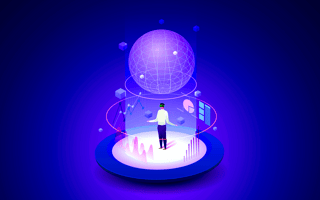Web5 is a decentralized version of the internet where users store their own personal information and can revoke access at will. Functioning as a peer-to-peer system built on top of Bitcoin blockchain infrastructure, Web5 is detached from any base blockchain network and operates completely through decentralized web nodes.
What Is Web5?
Web5 is a decentralized, peer-to-peer vision of the web built exclusively on a second layer of the Bitcoin blockchain. With Web5, users can store and manage access to personal information on their own terms.
Web5’s mission is to create an online system impermeable to the agenda-setting and governing powers of Big Tech companies, and to truly secure personal data by restoring the ownership of digital identity back to individual users. To do this, Web5 combines the user-friendly convenience of Web 2.0 with the mission of decentralization pioneered by Web3 design.
Unlike Web3, which stores data on public network solutions like Filecoin or the InterPlanetary File System (IPFS), Web5 lets users store and control their own data with decentralized web nodes. The Web5 framework also doesn’t use smart contracts or tokens to function like Web3 does.
“The fundamental purpose of Web5 is to give users control over their data,” said Michael Pierce, CEO of NotCommon, a multi-cross-chained Web3 platform that alerts non-fungible token (NFT) collectors of security threats targeting their pieces. “Essentially, the concept attempts to democratize the web by eliminating gatekeepers that effectively centralize technology.”
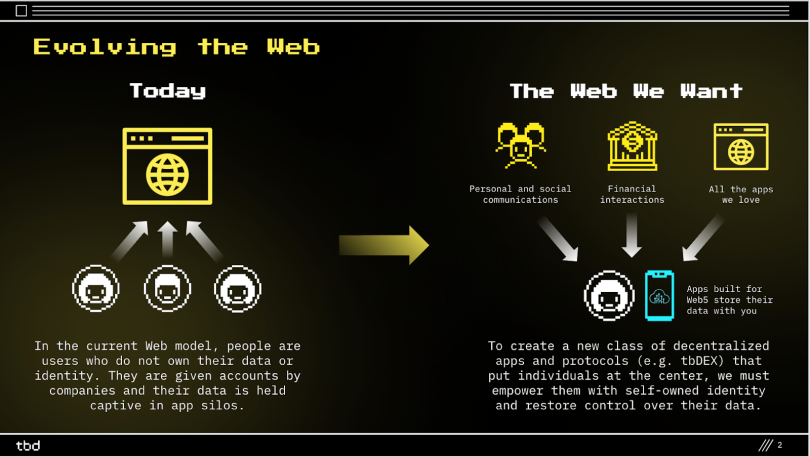
Who Is Creating Web5?
Former Twitter CEO Jack Dorsey became the face of Web5 in 2022 after sharing his vision of the next web at the crypto and blockchain conference Consensus. He’s backed by his team at TBD, the Bitcoin-focused division of his fintech company Block, formerly known as Square.
To Dorsey, Web5 is a way of addressing his core concerns about Web3 — most notably that he believes it will never be fully decentralized.
How Does Web5 Work?
Web5 leverages the Bitcoin Lightning Network, a Layer 2 payment protocol that operates off of the main Bitcoin blockchain. Placing Web5 on this protocol allows rapid network functionality independent of tokens, transaction “gas” fees, trusted validators or additional consensus mechanisms — all in order to create a peer-to-peer infrastructure of personal servers and reduce centralized governance.
In a way, the decentralized web concept is a rudimentary return to Y2K-era tech. Another internet protocol, BitTorrent, acts as a working example of this concept. BitTorrent demonstrates a successful, open-source, peer-to-peer system with its file sharing services, as the original Napster did for music, albeit illegally.
The Pillars of Web5
According to TBD, the pillars of Web5 include:
Decentralized Identifier (DID)
A unique identifier that is self-generated and self-owned, acting as a universal digital signature enabling identity authentication and routing; similar cross-platform sign-in function to a Google account. Like a username or digital passport, it provides access and allows a user to seamlessly interact with decentralized applications (dApps).
Decentralized Wed Nodes (DWNs)
The constellation of machines that make up Web5’s peer-to-peer network. These computers act as personal servers that house data storage, relay messages and facilitate decentralized apps and protocols.
Decentralized Web Application (DWA)
An application that runs software protocols in order to allow nodes, and therefore Web5 users, to interface and share data.
Verifiable Credentials
A proof or certificate created by multiple users that verifies a claim or allows an interaction. They come in the form of standardized data formats and models secured by cryptography.
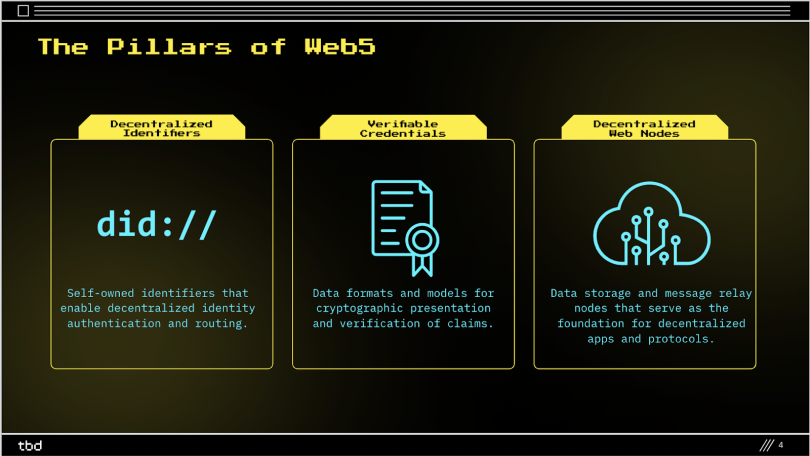
How Web5 Functions
In just two lines of the group’s presentation, TBD defined the vision and function of Web5:
“The Decentralized Web Platform (DWP) enables developers to write Decentralized Web Apps (DWAs) using Decentralized Identifiers (DIDs) and Decentralized Web Nodes (DWNs), returning ownership and control over identity and data to individuals,” reads one slide. “We are calling this Web5.”
During this process, one party sends a request to access certain information, such as a service or a file. With the help of empirical credentials, the receiving party may independently verify the peer identity before authorizing any sort of exchange. If satisfied, the users would then consentingly proceed with the transaction, which might involve signing onto a service or sending data from one node to another across in-network applications.
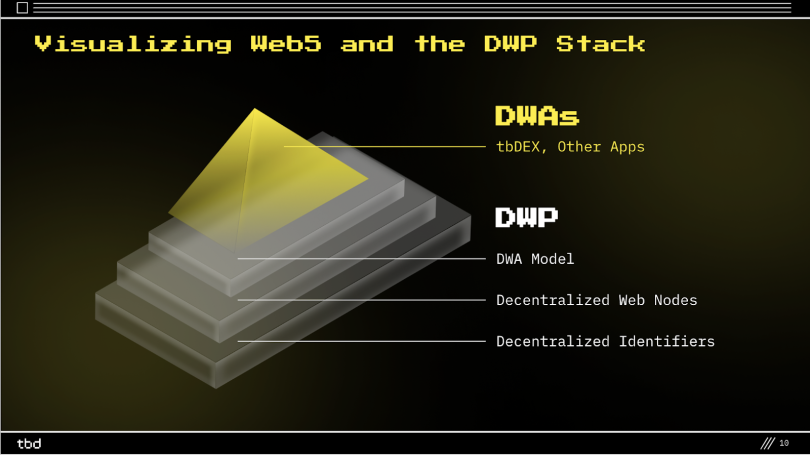
Decentralized Identity and Data
A standout feature of Web5 is its novel portability of decentralized digital identities.
“Web5 manages identity, digital currencies and related data across web applications in a portable way,” explained Mikael Kopteff, chief technology officer at tech agency Reaktor, which builds digital products and services for global brands. “This way, individuals own their own identity and data, instead of these things belonging to large corporations.”
Like a globally unique username or digital passport, the protocol adapts easy sign-in authorization across applications, except the log-in information — often collecting last names, phone numbers and addresses — stays with the user. This solution rejects current systems, like Google Accounts or Apple IDs, which indefinitely store sensitive details in the data silos of Big Tech conglomerates.
Not only does this mean users can seamlessly stream music or movies from dApp services without having to create an endless number of profiles, but it also alleviates the apathy some users may experience every time they boot up. As Pierce points out, the typical internet user “tends to opt for convenience over privacy and security.”
By positioning users as the sole managers of their data — encoded in a wallet stored on a node, or device — the choice to make personal data and information public, or revoke it, now lies with them.
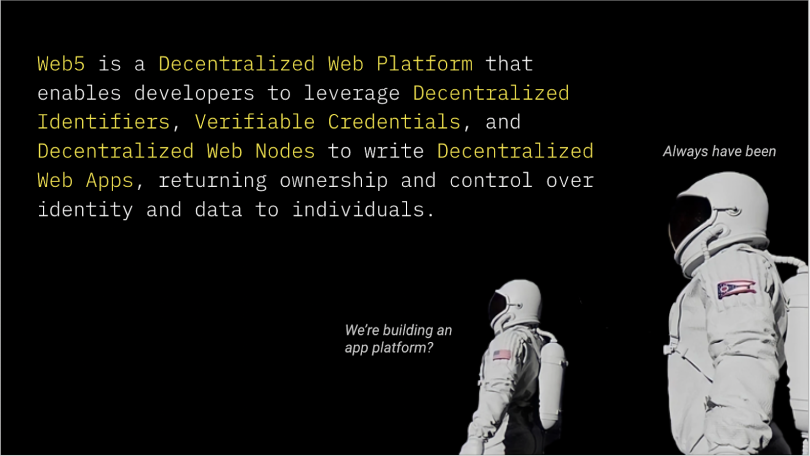
How Is Web5 Used?
Breaking it down further, TBD provides the following examples to reiterate Web5’s two main use cases: identity controls and data ownership.
IDENTITY CONTROLS
Users can switch dApps with ease using their unique digital wallet, where authorizations for external apps and connections are held. After a user has connected their decentralized identity to a dApp, there is no need to create a profile. All connections, relationships and posts that a user may create on a social media dApp, for example, would be stored in their decentralized web node, allowing users travel across platforms with a portable, social persona.
DATA OWNERSHIP
If a user wants recommendations for a new TV show or album, that user would then authorize their streaming service of choice to access their settings and preferences — reversing roles of the current system, where users are required to submit their personal details and create an account, forever locking their data in vendor-locked silos. This way, a user’s data stays in their personal server, or decentralized web node. Access can be revoked at any point by the user, who can enjoy these services until they decide to opt out.
Why Digital Identity Is Central to a User-Centric Web5
The key to a truly decentralized internet experience, free of venture capitalists and Silicon Valley insiders once and for all, is in protecting the digital identity — so says Dorsey’s team:
“The web democratized the exchange of information, but it’s missing a key layer: identity,” TBD explained in a presentation pack. “We struggle to secure personal data with hundreds of accounts and passwords we can’t remember. On the web today, identity and personal data have become the property of third parties.”
This challenge isn’t new, even if it feels more pronounced as the list of services we’ve signed up for and promptly forgotten about grows.
“Managing identity — meaning usernames, password, digital currencies and related personal data — across applications on the web has been a key struggle since the conception of the web,” Kopteff said.
First, there were SSO systems and 0Auth. Then Big Tech companies, like Google, Facebook and Apple, started providing social logins designed to simplify authentication for sites and apps.
“Managing identity — meaning usernames, password, digital currencies and related personal data — across applications on the web has been a key struggle since the conception of the web.”
“Today, these same industry giants are developing ways to make stronger claims about individual identities,” Kopteff warned.
For example, Apple has launched a new feature that allows users to store their driver’s licenses digitally in their Apple wallet, which is currently active in select U.S. states including Arizona.
“This poses a problem of those Big Tech companies controlling and owning your virtual identity and data related to that identity,” Kopteff explained.
As the lines blur between our in-person identities and online personas, users may be shocked at how much of the content hosted in their names — posted on their profiles or saved in a cloud — actually belongs to them. It may be time to start reading the fine print.
Web3 vs. Web5: What’s the Difference?
If Web5 sounds a tad similar to Web3, you’re not wrong. They’re both new-age iterations of the next generation of the internet that operate on open-source, peer-to-peer systems and share a goal of eliminating central authorities and censorship alike.
“The creation of Web5 does not imply the failure of Web3; They are just two approaches with a similar goal of decentralizing the internet,” said Josh Drake, chief operating officer at Dfinity Foundation, a not-for-profit organization developing a public blockchain known as Internet Computer Protocol. “The main difference is Web3 represents a diverse ecosystem of builders with a wide range of existing use cases and innovations, whereas Web5 is a relatively new platform, currently in its conceptual stage.”
Spotting the difference is a matter of studying each project’s process, as each web rendering-in-the-making offers a different thesis on how decentralization should be achieved.
WALLET STORAGE
Web3 wallets hold a user’s cryptocurrency, NFTs and other digital assets. These are secured by a set of alphanumeric codes, known as public and private keys, which encrypt and decrypt messages, respectively. Alternatively, Web5 wallets safeguard a user’s identity, data and authorizations for external apps and connections, kept safe on a user’s personal nodal server.
NO BLOCKCHAINS, NO SMART CONTRACTS
In Web3, dApps are run through smart contracts on public blockchains — the two staple technologies at the core of Web3. This method automates transactions via self-executing programs that secure an agreement between two parties by recording them on the blockchain. This creates a permissionless, trustless system, forming blocks one by one.
Web5, however, goes back to the basics, instead relying on a peer-to-peer network interconnected by decentralized nodes — the core structures of Web5 — that operate a new fleet of dApps, which, with the exception of its Bitcoin base layer, run independent of blockchains.
NO TOKENS
Cryptocurrency has been the gateway to Web3 tech for most users. Beyond investing and trading, token mechanisms hold additional utility as governance tools. In the context of a platform’s decentralized autonomous organization, or DAO, these tokens provide incentive for members to operate in good faith.
TBD’s version of a decentralized internet will not involve such tokens. Whether the under-construction project plans to implement a substitute, for purposes of governance or transactional tender, remains to be seen.
WORKING WITH WEB 2.0
Despite its unapologetically decentralized upbringing, Web5 doesn’t entirely write off the centralized platforms of Web 2.0. According to TBD’s pitch deck, Web5 plans include working with Web 2.0 services. This would authorize users access to streaming services already in popular use like Groove and Tidal through their decentralized identifier, saving playlists to their encrypted signature rather than a profile stored on the provider’s own servers.
What Happened to Web4?
Web4 didn’t exactly get skipped. Rather, it’s coexisting in its own league, being developed alongside Web 2.0, Web3 and Web5. In case you missed it, Web4 refers to the symbiotic web, and its goal is to organize metadata in such a way that allows for a mutual relationship between people and machines (think: robots) in which both parties function synergistically, in unison. Any services that interact with sensors and implants, natural language or virtual reality can be classified as Web4 tech.
When Will Web5 Launch?
The general consensus is that a fully functional Web5 is years away. Dorsey and his team have published plans to release a public beta platform by Q4 of 2023 in their TBDs roadmap.
“Since at least some of it is open source, if you are technically-savvy, you can already check it out at TBD’s website,” Kopteff said. “But for the general public, it’s going to be very hard to say.”
As with any startup, Web5’s success will largely depend on the number of companies, organizations and members of the public that grow the Bitcoin-embedded internet layer over the next few years, “especially once the hype starts dying out,” as Kopteff sees it.
“I wouldn’t expect any major breakthroughs in the next year or so,” he added.
Web5 Apps to Know
While Web5 is still in development, some apps are already experimenting with the technology and its decentralized web features. Here’s a few paving the way for a fully fledged Web5.
Bluesky
Bluesky is a social media app situated on the AT Protocol, a federated protocol built to make social networks function more as open systems like email or phone numbers. Bluesky applies a persistent DID to every user to foster a network ungoverned by a single stakeholder.
Bluesky’s development was kickstarted in 2019 by Jack Dorsey, with the aim of being an “open and decentralized standard for social media.” Dorsey also mentioned that the app “could be built on top of web5”.
Bluesky has seen increased interest following Elon Musk becoming Twitter’s CEO in 2022, and began beta testing with users in February 2023.
Damus
Damus is a social media app built on the Nostr protocol, a self-proclaimed censorship-resistant and decentralized social network. On Damus, data is not collected and there is no entity that can ban or censor posts, so users are completely in control of what information they share. The app supports this user ownership further by featuring end-to-end message encryption and not requiring identifiable information to register. Damus users can also tip other members with Bitcoin through use of the Bitcoin Lightning Network.
Zion
Zion is a Web5, peer-governed social network where users can post content for friends and subscribers, view content from other creators or chat in member-run communities. Zion provides users with custody of their own data by using DIDs, distributed DWNs and the Bitcoin Lightning Network. Users are also given Zion Lightning wallets, which are used to send and receive Bitcoin payments with no fees, and will eventually support other assets like NFTs and stablecoins.

